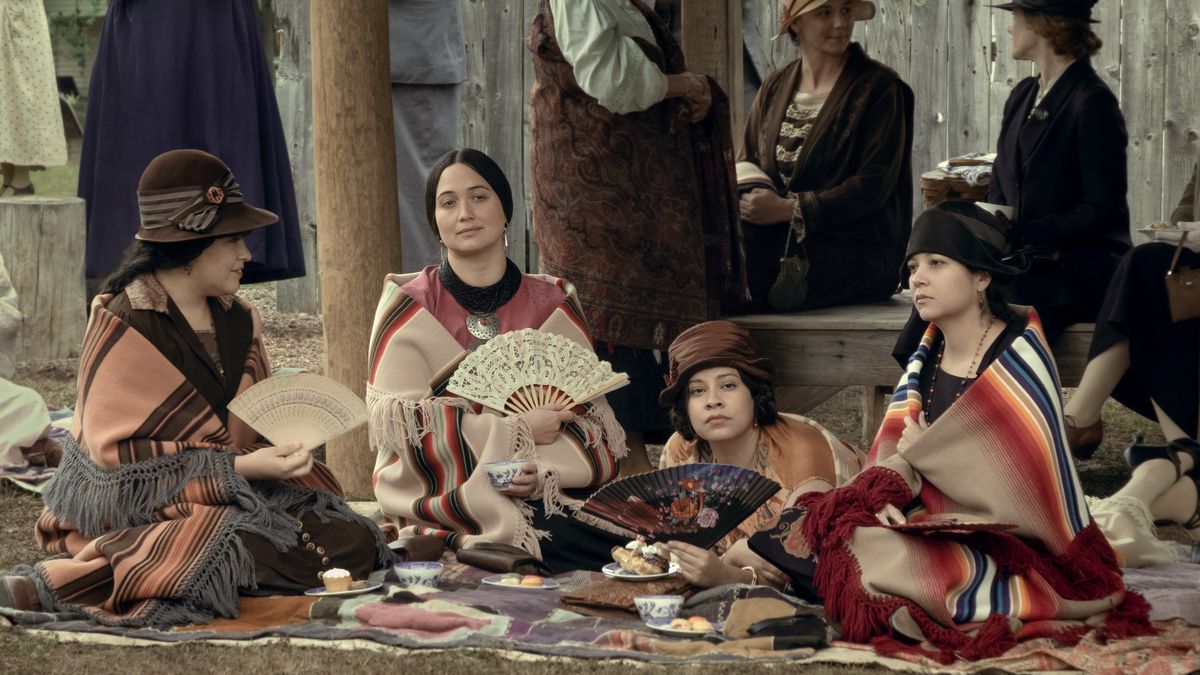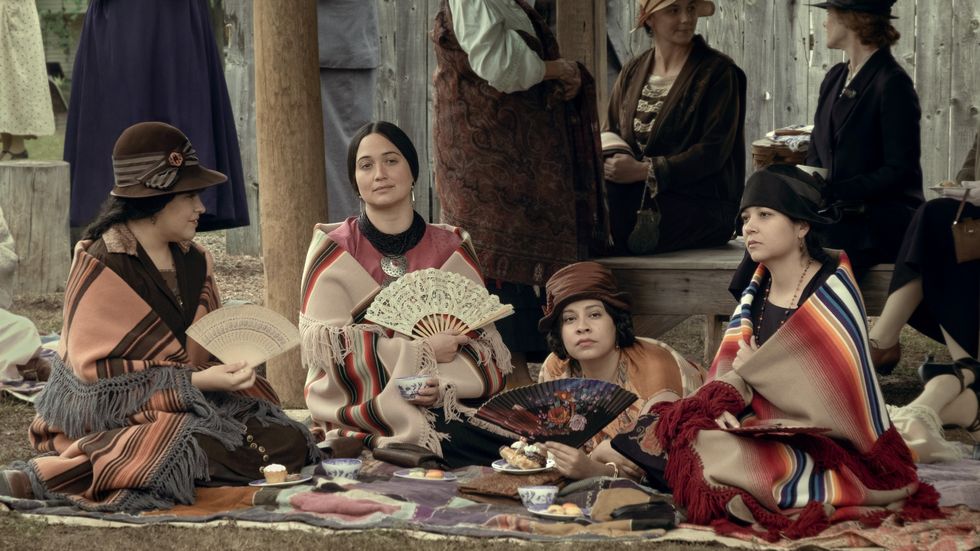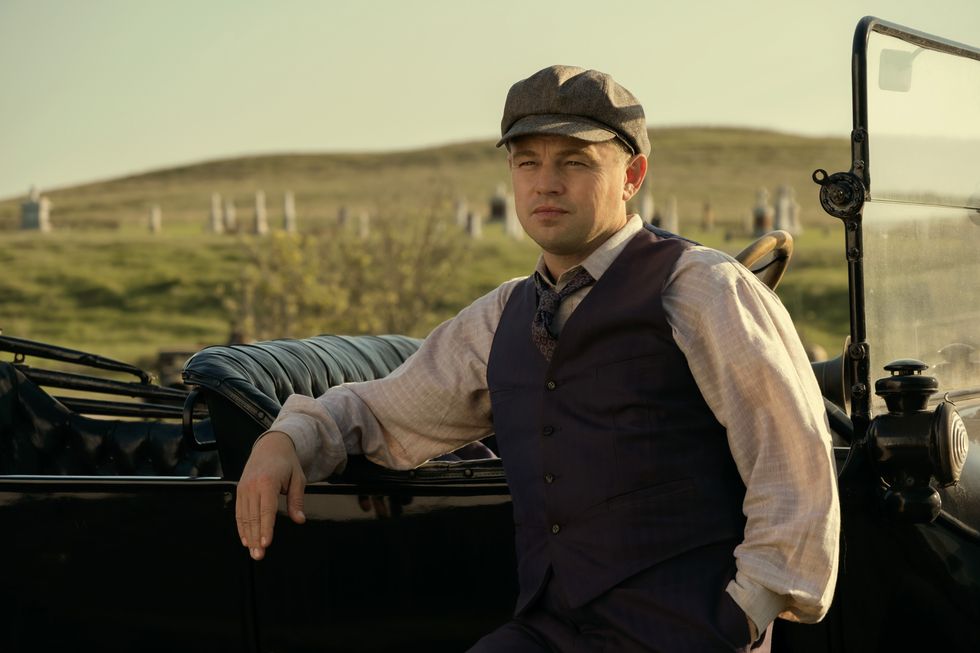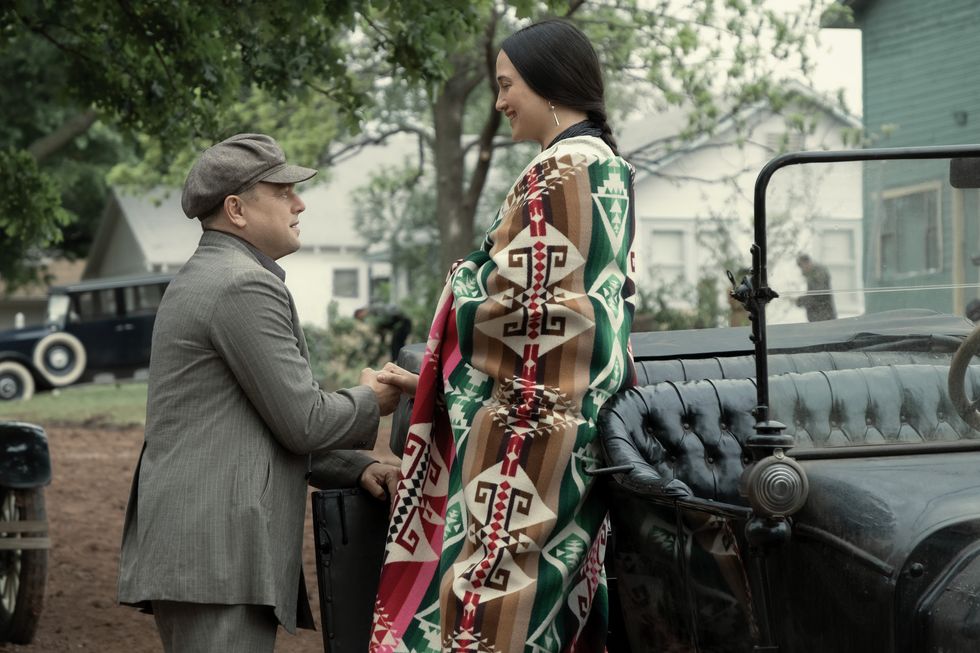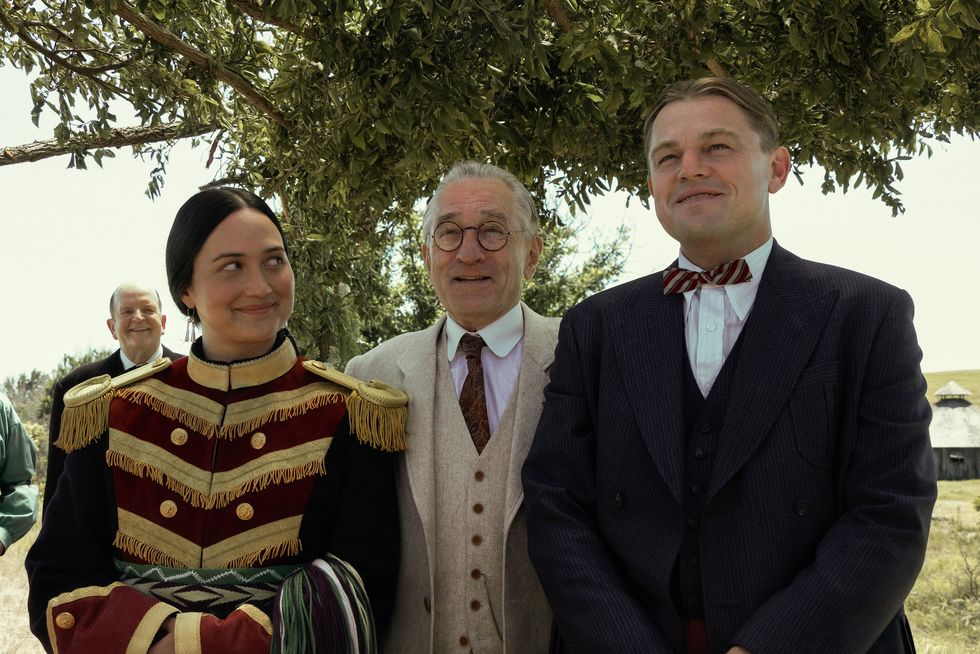For Julie O’Keefe, Killers of the Flower Moon was a community project like no other.
A member of the Osage Nation with a background in creating traditional, museum-quality regalia in her hometown of Pawhuska, Oklahoma, it’s easy to see why director Martin Scorsese and costume designer, Jacqueline West, asked O'Keefe to advise on the film. Based on David Grann’s nonfiction book, it covers a devastating period in the Native American tribe’s history, calling for a level of authenticity that Hollywood doesn't often hold itself to.
They turned to Julie for guidance. So Julie turned to her fellow Osage.
“We engaged a lot of the artisans that were in the community that can make those pieces, which really made it feel like less of a Hollywood project,” she tells me, sitting beside Jacqueline in a plush London hotel room in the build-up to the movie’s release. “These are ribbon work-makers that had been doing this in their families down through the generations, at least for 150 years. It's important that I serve my people. The film is a wonderful vehicle to really tell a story that's very difficult for us to talk about.”
That story is widely known as the Reign of Terror, a period of the 1920s in which the oil-rich Osage tribe were systematically oppressed and then killed off, one by one, by white interlopers seeking to make a claim on their wealth. The discovery of black gold came as a surprise to the indigenous tribe; the result of buying the rights for a lifeless stretch of land in Oklahoma that nobody else would want or, more importantly, try to push them off of. The money that arrived from the oil grew and grew over time, until the Osage eventually became the richest people, per capita, in the world.
Naturally, that had a fascinating impact on the tribe's attire, as traditional wardrobes were slowly integrated with à la mode European couture. The job of recreating the looks was made a lot easier by the wealth of archival photos that were made available. "The Osage Nation were the only people, except for the British Royal Family, that could afford to make home movies in the 1920s," says West, at a cost of $1,800 per minute of footage. "I must have pulled 1000 photographs that I took with me to Osage County".
Here's what they had to say about the power of authentic costuming in Scorsese's latest epic (this interview has been edited for length and clarity):
The evolution of Osage clothing
Julie: I'm going to use an example of the actual family unit. We have the mother, Lizzie Q, who was raised on the prairie. She and her husband had it for everything they needed; plains Indians follow their food source. And she still dressed traditionally in 1920, but by this point she has these daughters. They're taken away to go to missionary school, mandated by the government. They've gone to learn a language and it's being forced on them. They return home to their traditional mother, and they're trying to navigate how they're going to fit, safety-wise, into this world.
Anna, the eldest, has gone completely contemporary: she's a flapper. She has some of the behaviours of that, but she's struggling to figure out where she fits. Then you have Mollie, who has basically decided to stay traditional. She may have some very nice French shoes, or a nice handbag, but for the most part she's expressing herself in her culture, and showing that this is how she identifies.
Sisters Rita and Minnie, you see them in modern clothing, but you also see them wearing their Osage blanket. It's a piece of culture that they're still going to keep, as part of our traditions; wherever they go, it doesn't matter whether it's the bank or to church, they're wearing these blankets.
So when you see these characters portrayed in these clothes, you're seeing a human struggle. How are we going to fit in and stay safe?
On sourcing the Osage blankets
Jacqueline: Pendleton blankets were a status symbol and a treasure to several plains nations like the Sioux Nation. When Calvin Coolidge came to Rushmore, South Dakota, he was given stacks of Pendleton Blankets.
I was always a fan of the blankets and I heard that they made particular ones for the Osage in a certain palette. They sent me a printout of the colours that they made in the 1920s from their art archives. I had all these shots, and I just sent that to them. I said, Copy all those, and they made me, I'd say, over 500 blankets – all with the 1920s label, in the colours that the Osage were particularly fond of.
Julie: For men, there are five different ways that you can wear a blanket. It's always around your life event, what's happening that day. We had photographs of a gentleman that was out branding cattle in 1920 – an Osage man, wearing a cowboy hat on long braids. He's got a vest and caucasian clothing on. But then he's got a blanket around his waist, which is exactly how men used to wear it. Then you see Chief Bonnicastle: in the movie, he wears his blanket over his shoulders in a long way that's rolled up a little bit, called peyote style, because he is a leader. He's showing power within that blanket. And then some have them just over their shoulders, like at the council meeting. You still see leaders, but they have them up on their shoulders or across. As you're looking through, you can start to see immediately who the leaders are, depending on how they're wearing their blanket.
On Ernest's wardrobe
Jacqueline: Early on, I found a wonderful photograph of a young non-Osage man which was my guiding light. He was sitting in a taxi at this station, waiting to drive Osage travellers coming back from the East Coast or Colorado Springs, and he had on a not-very-elegant, little baggy gabardine suit – that rayon gabardine from the Twenties – with a tie and flat cap. Leo loved it. I had already shown it to Marty, who thought it was perfect, because Ernest is a doughboy from World War One; he doesn't have the means to go shopping, and William Hale would probably get him a Sears catalogue suit when he decides to make Ernest a cabdriver. So that started from there.
Then he meets Mollie, and the first thing she gets him is a Stetson hat with the cattleman crease. That's her claiming him, kind of; that’s the start of their relationship. I think he's surprised when she gives it to him. But as he marries her, he becomes more dandified.
There are just a couple of pictures of [the real-life] Ernest with his kid, and his suits are Western-inclined. But you don’t see pictures of Ernest dressed up, and there’s so little research on him, so I used a few references. I found some incredible pictures of [Hollywood’s first Western star] Tom Mix, who lived in Pawhuska – everyone was seeing him in movies, and he had his suits made at a Pawhuska tailor. He had a very Western style and I thought that was great for Leo's character.
Then there was a pair of boots that Tom Nix wore. A friend of mine in Belle Fourche, South Dakota, his family made those boots for Tom Nix. The hats are from Weather Hats, which is also in Belle Fourche, because they made a lot of Westerns in South Dakota. John Wilson at Cowboy Too! handmade all the Osage boots for me, because I needed a lot that Spanish style. These are family businesses that existed back in the 1920s. And then I watched a movie my husband found for me, called The Winning of Barbara Worth by Henry King, with Ronald Coleman and Gary Cooper. I used Gary Cooper's wardrobe for when Leo was doing robberies with his cousins, with the buckle back jeans. I grabbed his coat from Blood on the Moon, which is a movie I love, and Marty loves too.

Nick Pope is the Site Director of Esquire, overseeing digital strategy for the brand.
